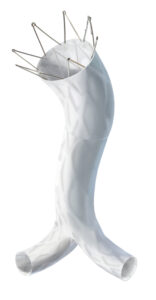
Endologix has announced the online publication of the final five-year results of the LEOPARD trial in the Journal of Vascular Surgery (JVS). The study’s findings showed that there was no significant difference in aneurysm-related outcomes between patients randomised to the AFX endograft system, with anatomical fixation, and commercially available endografts with proximal fixation.
“The publication of these final five-year results in JVS reinforces the performance of our AFX2 endovascular AAA [abdominal aortic aneurysm] system in the treatment of patients with [AAAs],” said Matt Thompson, president and CEO of Endologix. “We are proud to have conducted the first randomised controlled trial comparing commercially available endografts, and we remain committed to providing the highest quality clinical evidence that underpins our life-changing vascular therapies. Importantly, the comparable performance results from the LEOPARD study between AFX/AFX2 and other endografts align with a recent publication that was authored on behalf of the Society for Vascular Surgery’s Patient Safety Organization and used linked registry claims data.”
LEOPARD was a prospective, randomised, multicentre trial that enrolled 455 patients across 56 US centres. Two hundred and thirty five patients were included in the AFX/AFX2 arm and 220 patients in the comparator arm.
The primary endpoint was freedom from aneurysm-related complications (ARC), a composite endpoint consisting of perioperative death, aneurysm rupture, conversion to open surgical repair, postoperative endoleaks, endograft migration, aneurysm enlargement, endograft limb occlusion, and device- or aneurysm-related reintervention.
The results presented included:
- Freedom from ARC at five years was:
- 63.8% in AFX/ AFX2 device cohort
- 55.5% in comparator endografts
- There was no clinically significant difference in aneurysm-related mortality, all-cause mortality, rupture, secondary interventions, and type 1 and type 3 endoleaks between the two cohorts
- The type 3 endoleak rate for the AFX/AFX2 device cohort was 1.5% at five years and was not statistically different from the comparator devices
- The type 2 endoleak rate reached a statistically significant lower rate at 21.2% at five years for the AFX2 cohort than the rate of 31.6% seen with the comparator devices













